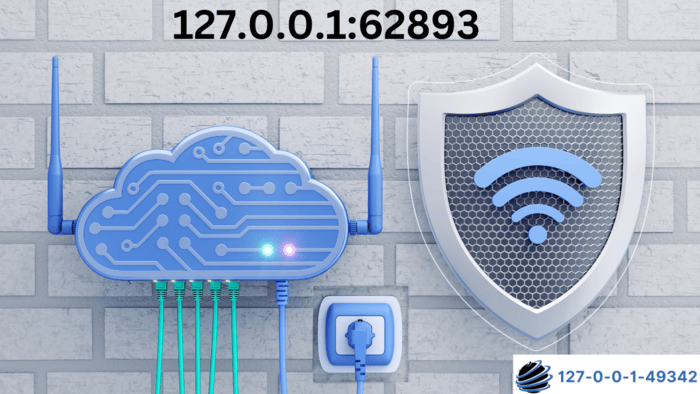If you have encountered the term “127.0.0.1:62893,” it might initially seem perplexing. However, grasping its meaning and purpose can be highly advantageous, especially in software development.
This post explains the components of 127.0.0.1:62893, how it works, and how to address commonly associated issues.

Breaking Down the Code
The combination “127.0.0.1:62893” consists of two critical elements:
| Component | Description |
| 127.0.0.1 | “localhost” refers to an IP address used for internal communication within the same device. |
| 62893 | A port number that allows data transfer for a specific service or application. |
For instance, port 62893 is often linked to Memcached, a tool for caching data. This setup ensures that applications can handle data efficiently and reliably.
Benefits of Using 127.0.0.1:62893
Here are some practical uses for this address and port combination:
- Application Testing: Developers rely on localhost to test software securely and isolatedly. This prevents errors or bugs from affecting a live environment.
- Network Learning: It helps understand basic networking concepts like client-server communication. Beginners in networking often start by experimenting with localhost setups.
- Enhanced Security: Monitoring port activity can help identify unauthorized access attempts. This proactive approach strengthens the overall security of your system.
- Issue Resolution: Localhost provides a controlled environment for debugging network-related problems. Developers can identify and resolve issues without external interference.
- Service Isolation: Running services locally prevents interference from other applications. This isolation ensures that services operate independently and do not conflict.
The versatility of 127.0.0.1:62893 makes it a valuable tool for developers and network engineers alike.
How It Operates?
The mechanism of 127.0.0.1:62893 is straightforward:
- A program on your system initiates communication.
- The address 127.0.0.1 ensures all communication stays confined to your own device.
- The operating system uses port number 62893 to identify the relevant application or service.
For example, a developer might use this address to connect a debugger to a local server. This setup ensures seamless communication between tools and services during the development process.
Understanding how 127.0.0.1:62893 functions can help optimize workflows and improve troubleshooting techniques.
Risks of Exposing Port 62893
Making port 62893 accessible externally can lead to security risks:
- Potential Exploitation: If Memcached operates on this port, attackers might exploit vulnerabilities if it’s not secured. Such exploits can compromise sensitive data.
- Overloading: Attackers could launch Denial-of-Service (DoS) attacks, causing system crashes. This disrupts the availability of critical services.
- Unauthorized Access: Leaving this port open might allow unwanted access to sensitive services. Unauthorized users can manipulate data or disrupt operations.
To mitigate these risks, it’s essential to secure port 62893 and limit its exposure to trusted sources.
Resolving Common Errors
One frequent issue is the error message: “Disconnected from the target VM, address: 127.0.0.1:62893.” This usually occurs in development environments when debugging tools fail to connect. Here are some steps to resolve it:
Confirm Service Status
- Check if the service or application linked to port 62893 is active.
- Restart the service to ensure it’s functioning correctly.
Validate Port Settings
- Ensure the port number specified in the application’s configuration matches.
- Update the configuration if discrepancies are found.
Modify Firewall Rules
- Allow local connections to port 62893 in the firewall settings. This ensures that the application can communicate effectively.
Additional Troubleshooting Tips
If problems persist, try these solutions:
| Problem | Solution |
| Service not running | Restart the service using appropriate commands or scripts. |
| Port conflict | Reassign the application to a different port. |
| Firewall blocking | Add a firewall rule to permit communication on port 62893. |
For Windows:
- Go to Control Panel > System and Security > Windows Defender Firewall > Advanced Settings > Inbound Rules.
- Create a new rule allowing traffic on port 62893.
For Mac/Linux:
- Use terminal commands like IPtables to adjust firewall settings.
Check for Port Usage
- Run tools like netstat (Windows) or lsof (Unix/Linux) to identify any conflicting processes using port 62893. This step helps pinpoint issues related to port availability.
Verify Application Configuration
- Refer to your application’s documentation to ensure proper setup. Documentation often includes troubleshooting steps tailored to specific software.
Switch Ports if Necessary
- If port 62893 is unavailable, configure your application to use an alternative port. This can resolve conflicts and restore functionality.
Summary
The combination “127.0.0.1:62893” is essential for local development and troubleshooting. The IP address 127.0.0.1 designates localhost, facilitating internal communication, while port 62893 connects specific services or programs. Together, they enable efficient testing, debugging, and secure data handling. We have also created troubleshooting guides for other variations of this IP address, such as ‘127.0.0.1:7860 unavailable’ and ‘127.0.0.1:57573 admin login‘, which you can refer to as needed.
Understanding how to use and troubleshoot 127.0.0.1:62893 ensures smooth and secure operations on your device. By applying these insights, you can confidently manage tasks involving local hosts and improve the reliability of your systems.
